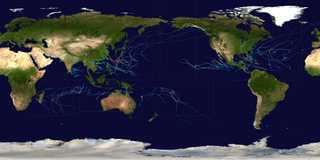The name Bill has been used for five tropical cyclones in the Atlantic Ocean.
The name Iris was used for three tropical cyclones in the Atlantic Ocean.
The name Olga has been used for sixteen tropical cyclones worldwide: three in the Atlantic Ocean, ten in the Western Pacific Ocean, and three in the Australian region in Southern Hemisphere.
The name Gordon has been used for ten tropical cyclones world-wide.
The name Jose has been used for six tropical cyclones worldwide, five in the Atlantic Ocean and one in the Western Pacific Ocean, a typhoon that traversed the Philippine Atmospheric, Geophysical and Astronomical Services Administration (PAGASA) area of responsibility. The name was retired by PAGASA from future use in the region after that one use, and replaced with Josie for the 2018 Pacific typhoon season.
The name Cora has been used for one tropical cyclone in the Atlantic Ocean, eight in the western Pacific, and one in the South Pacific.
The name Gloria has been used for eighteen tropical cyclones worldwide: three in the Atlantic Ocean, two in the Australian region, one in the South-West Indian Ocean, and twelve in the Western Pacific Ocean. It has also been applied to one extratropical European windstorm.
The name Alice has been used for eighteen tropical cyclones worldwide: four in the Atlantic Ocean, ten in the Western Pacific Ocean, one in the South-West Indian Ocean, and three in the Australian region.
The name Ike has been used for three tropical cyclones worldwide, one in the Atlantic Ocean and two in the Western Pacific Ocean.
The name Tomas has been used for five tropical cyclones worldwide: one in the Atlantic Ocean, two in the Philippines by PAGASA in the Western Pacific Ocean, and two in the South Pacific Ocean.

During 2005, tropical cyclones formed within seven different tropical cyclone basins, located within various parts of the Atlantic, Pacific and Indian Oceans. During the year, a total of 141 systems formed with 94 of these developing further and were named by the responsible warning centre. The strongest tropical cyclone of the year was Hurricane Wilma, which was estimated to have a minimum barometric pressure of 882 hPa (26.05 inHg).

Throughout 2006, 133 tropical cyclones formed in seven bodies of water known as tropical cyclone basins. Of these, 80 have been named, including two tropical cyclones in the South Atlantic Ocean, and a tropical cyclone in the Mediterranean Sea, by various weather agencies when they attained maximum sustained winds of 65 km/h (40 mph). The strongest storms of the year were Typhoon Yagi in the Western Pacific, and Cyclone Glenda of the Australian region. The deadliest and costliest storms of the year were a series of five typhoons that struck the Philippines; Chanchu, Bilis, Saomai, Xangsane, and Durian, with most of the damage being caused by Durian of November. Five Category 5 tropical cyclones were formed in 2006.
The name Marilyn has been used for one tropical cyclone in Atlantic Ocean and two in the Philippines by the PAGASA in the Western Pacific Ocean.

During 2019, tropical cyclones formed within seven different tropical cyclone basins, located within various parts of the Atlantic, Pacific and Indian Oceans. During the year, a total of 150 systems formed with 102 of these developing further and were named by the responsible warning centre. The strongest tropical cyclone of the year was Typhoon Halong, which was estimated to have a minimum barometric pressure of 905 hPa (26.72 inHg), Halong also has the highest wind-speed, with 1-minute sustained wind speed of 305 kilometres per hour (190 mph).

During 2020, tropical cyclones formed within seven different tropical cyclone basins, located within various parts of the Atlantic, Pacific and Indian Oceans. During the year, 141 tropical cyclones formed in bodies of water known as tropical cyclone basins. Of these, 104, including three subtropical cyclones in the South Atlantic Ocean and three tropical-like cyclones in the Mediterranean, were named by various weather agencies when they attained maximum sustained winds of 35 knots. The strongest storm of the year was Typhoon Goni, peaking with a pressure of 905 hPa (26.72 inHg) and with 10-minute sustained winds of 220 km/h (140 mph). The deadliest storm of the year was Hurricane Eta which caused 175 fatalities and another 100+ to be missing in Central America and the US, while the costliest storm of the year was Hurricane Laura, with a damage cost around $19.1 billion in the Greater Antilles, The Bahamas, and the Gulf Coast of the United States.
This page is based on this
Wikipedia article Text is available under the
CC BY-SA 4.0 license; additional terms may apply.
Images, videos and audio are available under their respective licenses.



